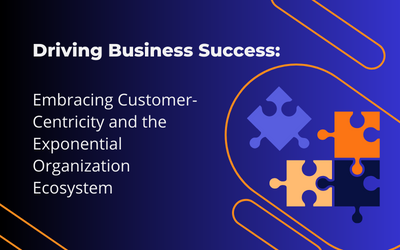Driving Business Success: Embracing Customer-Centricity and the Exponential Organization Ecosystem
Unlock the secret to business success by understanding your customers’ true needs and leveraging the power of the Jobs-to-be-Done theory. Dive into the Exponential Organization ecosystem and discover how SMEs can tap into exponential technologies, gain a competitive edge, and create the exceptional value that exceeds customer expectations.
Understanding Customer Needs: The Key to Business Success
In the world of business, understanding customer needs and delivering products or services that satisfy those needs is crucial for success. One framework that provides valuable insights into this process is the Jobs-to-be-Done theory. This theory emphasizes that customers “hire” products or services to get a job done. It goes beyond traditional demographics and focuses on understanding the underlying motivations and goals that drive customer behavior. By adopting the Jobs-to-be-Done perspective, businesses can better understand their customers’ needs and develop solutions that truly address their desired outcomes. This approach enables companies to create products and services that meet customer expectations and exceed them, leading to greater customer satisfaction and business success.
The Exponential Organization Ecosystem: An Example
To illustrate the concept further, let’s look at the Exponential Organization (ExO) ecosystem. This ecosystem comprises a global network of experts and coaches in exponential technologies and approaches. SMEs can tap into this ecosystem to leverage the knowledge and expertise of its members. By doing so, SMEs can accelerate their growth, gain a competitive edge, and address their customers’ true needs more effectively.
Opportunities within the Exponential Organization Ecosystem
Within the ExO ecosystem, there are numerous opportunities that SMEs can explore. For example, SMEs may hire ExO members as consultants to help them implement Exponential Organization attributes such as Interfaces, Autonomy, and Social Technologies into their business strategy. These attributes enable SMEs to create innovative business models, develop new products or services, and optimize processes using advanced technologies.
Additionally, SMEs may hire ExO members as project managers, developers, or designers for projects related to exponential technologies like blockchain, artificial intelligence, or the Internet of Things. The expertise of ExO members in these areas can contribute to the successful implementation of projects that leverage these cutting-edge technologies.
Furthermore, SMEs can benefit from hiring ExO members as trainers or coaches who can educate their employees on exponential technologies and approaches. This training can empower employees to incorporate emerging technologies into their day-to-day operations and use social technologies for collaboration, leading to enhanced productivity and efficiency.
The Benefits of Hiring ExO Members
By hiring ExO members from the ExO ecosystem, SMEs gain access to a diverse pool of experts who specialize in exponential technologies and approaches. These experts deeply understand the latest trends, strategies, and best practices in the field. SMEs can leverage this knowledge to drive innovation, enhance efficiency, and create new opportunities for growth and impact.
The Limitations of Traditional Solutions
In contrast, SMEs that rely on traditional consultants or contractors may not benefit from the same depth of knowledge and expertise in exponential technologies. In-house staff may also lack the necessary skills or experience to implement these technologies and approaches effectively. This can result in slower adoption or less effective implementation, leading to decreased competitiveness and growth for the SME.
Prioritizing Customer Needs for Business Success
Many products fail because companies approach them from the wrong angle. Instead of solely focusing on what to sell, companies should prioritize understanding their customers’ true needs. It’s essential to grasp the problems customers are trying to solve and tailor your offerings accordingly. Remember, there’s no one-size-fits-all solution. Start by comprehending the job your customer wants to accomplish, and then actively engage in fulfilling that role. Dedicate your time and energy to making your customers happy by doing what it takes to meet their expectations.
By adopting the Jobs-to-be-Done theory and leveraging the expertise of the Exponential Organization ecosystem, SMEs can align their strategies with their customers’ true needs. They can tap into the vast knowledge and experience of ExO members to implement exponential technologies, develop innovative business models, and drive growth and impact. This approach allows SMEs to stay ahead of the competition and provide exceptional value to their customers.
Conclusion
Understanding customer needs is a fundamental aspect of business success. The Jobs-to-be-Done theory offers a valuable framework for gaining deeper insights into customers’ motivations and goals. By prioritizing customer needs and leveraging the expertise within ecosystems like the Exponential Organization, SMEs can create meaningful solutions that address their customers’ true needs, leading to enhanced competitiveness, growth, and customer satisfaction. Embrace the Jobs-to-be-Done approach and unlock the full potential of your business by putting your customers at the heart of everything you do.
Table of Contents
